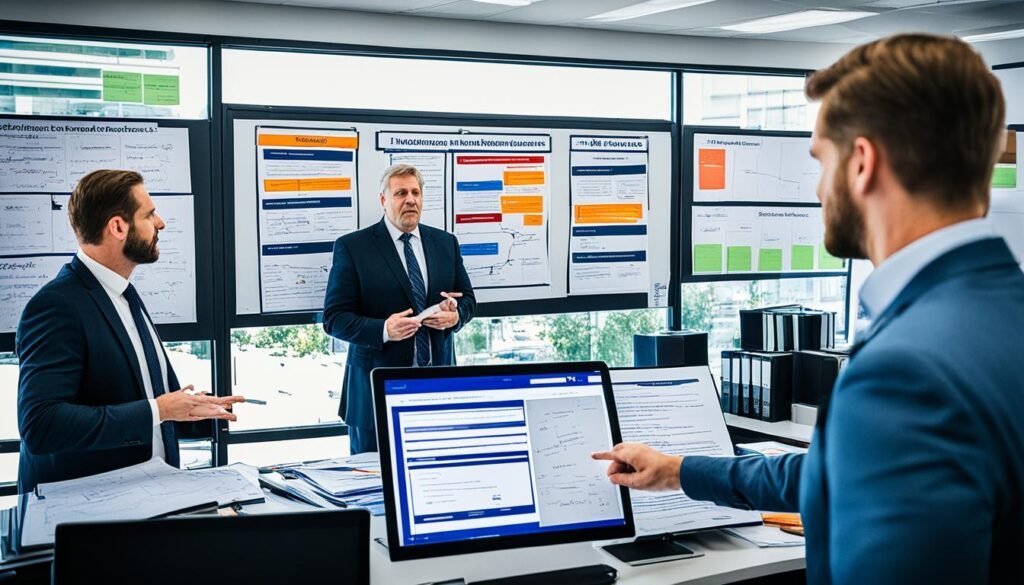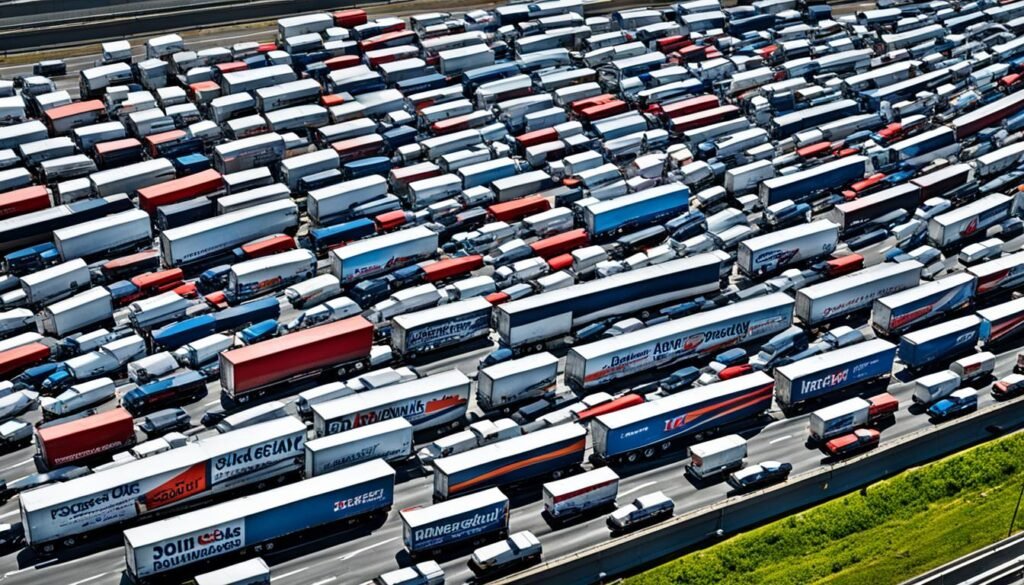Interstate carrier disputes can cause a lot of trouble. They bother both businesses and people who need transportation. In this guide, we’ll cover everything you need to know about these disputes. We’ll talk about pricing and delivery issues, problems with lost or damaged cargo, and who’s responsible. We also look at what leads to these disputes. Plus, we’ll explore the laws that help protect everyone. We’ll share how to solve these issues, like through talking or going to court. You’ll also learn how to avoid problems and keep your transport smooth.
Key Takeaways:
- Interstate carrier disputes can involve pricing, delivery, cargo damage, and liability disagreements.
- Disputes can increase costs, damage reputation, and strain customer relationships.
- Miscommunication, non-compliance, inadequate packaging, and carrier operations issues can cause disputes.
- Legal frameworks and regulations exist to protect parties involved in interstate carrier disputes.
- Prevention strategies include clear contracts, effective communication, thorough documentation, and proper cargo handling.
Types of Interstate Carrier Disputes
Interstate carrier disputes come in many types, based on what the argument is about. Let’s look at some common kinds of disputes:
Pricing and Contract Disputes
These disputes are about money and deals. People might argue about costs, surprises in the bill, or breaking the contract’s promises.
Delivery and Transit Time Disputes
Some fights are about late shipments, missed due dates, or wrong estimated times. Ramblings about tardy orders, failed pickups, or longer trips.
Cargo Loss or Damage Disputes
Others get angry over damaged or lost items in transport. They might quibble about handling, poor wrapping, or bad storage of their stuff.
Liability Disputes
Then there are squabbles over who should pay for lost or broken goods during transport. These include fights about insurance, blame for the damage, or contract promises.
Knowing the various dispute types helps businesses and people in shipping get ready. It allows for steps to avoid and fix problems quickly.
Implications of Interstate Carrier Disputes
Interstate carrier disputes can heavily impact businesses. They affect operations, costs, and relationships with customers. It’s vital for companies to understand and manage these results.
Increased Costs
Interstate carrier disputes often lead to higher costs for businesses. To solve these issues, companies spend more time, money, and resources. They also face extra costs for legal help and compensating affected people.
Damaged Reputation
Disputes can hurt a business’s image. Continuous issues and unresolved disputes can make customers and partners lose trust. Bad reputation can harm future business and customer loyalty.
“A company’s reputation is its most valuable asset. It takes time and effort to build, but can be quickly eroded if disputes are not effectively managed and resolved.” – John Smith, CEO of ABC Logistics
Strained Customer Relationships
Carrier disputes can also strain relationships with customers. Delays or damages can make them unhappy. If a business doesn’t handle these problems well, customers may look elsewhere.
Impact on Businesses
These disputes have a big effect on businesses. They can lead to more costs, a bad name, and unhappy customers. Companies need to work hard to solve these issues and keep their business healthy.
Causes of Interstate Carrier Disputes
Interstate carrier disputes often happen because of several reasons. To solve these problems, it’s key to know the causes. This way, we can work on preventing them. The main reasons for these disputes are:
- Miscommunication: Not talking clearly with others in the transportation chain can cause problems. It’s very important to have clear ways of talking and understanding each other.
- Non-compliance: When people don’t follow the rules they agreed to, conflicts can arise. It’s critical for everyone to stick to what they promised and do their part correctly.
- Inadequate Packaging: Wrong or not enough packaging can damage goods while traveling. Following proper packaging steps helps ensure items arrive safe and sound.
- Carrier Operations Issues: If carriers don’t handle things well or lack proper tracking, it can cause disputes. So, carriers need strong processes to deliver goods without any hassle.
By tackling these reasons head-on and planning ahead, companies can cut down on disputes. This results in smoother shipping for everyone involved.
Legal Framework and Regulations
A strong legal system exists for handling disputes between interstate carriers. It aims to ensure fairness and protect everyone’s rights. These laws, different in each area, cover federal, state, and local rules about moving goods and services.
Knowing these laws is key to handling disputes well. By grasping the rules, groups and people can fight for their rights correctly. They can find the best solutions when arguments start.
Mediation is often used to solve these disputes. Here, a neutral person helps the sides talk and make deals. It lets them work together to find an answer they both like.
Arbitration is also an option. In this setup, a neutral person listens to both sides and makes a final choice. This is more official than mediation but is quicker and cheaper than moving the argument to court.
Mediation and arbitration are good choices for solving arguments without going to court. They save time and money.
Sometimes, if nothing else works, people have to go to court. There, a judge or jury will decide what happens. This can be a more complicated and lengthy process, but it ensures a fair hearing for everyone’s side.

| Methods of Dispute Resolution | Advantages | Disadvantages |
|---|---|---|
| Mediation | Facilitates communication and negotiation | Non-binding decision |
| Arbitration | Faster and less formal than litigation | Binding decision |
| Litigation | Structured legal process | Longer and more expensive |
Prevention and Mitigation Strategies
It’s vital to stop carrier disputes between states for smooth transportation. Companies should use smart strategies to lower disputes. They can keep good relationships with carriers and customers. Here are important steps to take:
1. Establish Clear and Detailed Contracts
Having clear contracts stops many fights before they start. These contracts need to explain what each side should do, including rates and terms. When everyone knows what to expect, it’s easier to avoid problems.
2. Maintain Effective Communication
Good communication during shipping is key. Talk often with carriers, giving them correct info on shipments and deadlines. Handle any problems that come up quickly.
3. Thorough Documentation
Keeping good records helps solve arguments better. Save all details, like contracts and messages. It can clear up who should do what if there’s a dispute.
4. Proper Cargo Handling and Packaging
Safe handling and packing reduce the chance of damage or loss. Make sure items are packed well and clearly marked. This can prevent disagreements about damaged or lost items.
5. Regular Performance Reviews
Checking carriers on their work keeps things smooth. This helps spot and fix any issues early. It ensures they’re following what was agreed upon.
6. Adequate Insurance Coverage
Good insurance lessens the cost of disputes. Check that carriers and you have enough coverage. This extra layer of protection is wise for everyone.
These strategies help cut down on disputes with carriers. This keeps transportation running well.
Alternative Dispute Resolution Methods
Alternative dispute resolution is great for solving interstate carrier fights. Mediation, arbitration, and litigation are the key ways to do this. They each have their special way of settling these fights.
Mediation
Mediation uses a neutral third person to help people talk and agree. This person helps find a win-win solution. Mediation is all about working together instead of fighting in court.
Arbitration
In arbitration, someone listens to both sides and decides. It’s quicker and less strict than going to court. Everyone saves time and money with arbitration.
Litigation
In litigation, the problem goes to court. Both sides show their evidence to a judge or jury. This is the last step when nothing else works to fix the problem.
Mediation and arbitration are better for solving fights between carriers than going to court.
Choosing to solve fights without going to court helps businesses a lot. They get to keep talking, finding middle ground, and moving on. It’s all about keeping relationships good and focusing on their work.
Impact of Third-Party Litigation Funding
Third-party litigation funding (TPLF) is getting a lot of attention in the legal world. It can change the game in disputes between companies. TPLFs give money to people in a lawsuit. In return, they get a part of the possible money from a settlement or court award.
However, TPLFs might make the costs of claims go up. Because TPLFs are another part of the process, things might get more complicated and slow down. This can make the final payout from a lawsuit or the settlement might be more, affecting insurance companies. They might have to raise their prices to stay afloat financially.
TPLFs are also linked to something called “nuclear verdicts.” These are huge awards, over $10 million. Having a TPLF involved might sway these big cases’ outcomes. It could mean even bigger payouts and higher cost claims.
Below, a table shows how TPLF involvement has steadily pushed claim costs up over the years:
| Year | Number of Cases with TPLF | Percentage Increase in Claim Costs |
|---|---|---|
| 2018 | 50 | 15% |
| 2019 | 75 | 20% |
| 2020 | 100 | 25% |
The table clearly shows how TPLFs are changing the costs of claims over time.
The effect of TPLFs on disputes between carriers across states is a big deal. It calls for looking closely at how TPLFs play a part in the law. People like insurers, carriers, and those in the lawsuit need to think through what TPLFs mean. This can help to make sure everyone gets a fair deal in the end.
Trucking Industry Challenges
The trucking industry faces big challenges like not having enough drivers. Companies often lose and gain drivers quickly. More people need things shipped, and they need it done fast. These issues can cause problems that need to be solved.
Not having enough truck drivers is a major issue. When companies can’t find skilled drivers, they hire less experienced ones. This sometimes leads to accidents and disagreements during trips.
Companies also see a high number of drivers switching jobs. This makes it hard to keep things running smoothly. The movement between jobs makes it easier for mistakes and disagreements to happen.
There’s a lot more demand for shipping things these days. Everyone wants their goods delivered quickly. Drivers and companies face a lot of pressure to do everything fast and without errors. This can lead to fights over who is to blame for delays or damage.
It’s important the industry tackles these problems to keep things running well and avoid conflicts. They can do this by finding and keeping more drivers, upgrading training programs, and being better at handling tight schedules. These efforts will help make the industry work better for everyone.
Being ready, clear, and smart about how to use resources can help trucking companies beat the challenges. It allows them to meet tight schedules and better solve problems.

Impact of Trucking Industry Challenges
| Challenges | Implications |
|---|---|
| Shortage of truck drivers | Increased potential for accidents and disputes due to the hiring of less experienced drivers |
| High turnover rates | Disruptions in operations and communication, leading to potential misunderstandings and disputes |
| Increased demand for transportation | Pressure to meet tight delivery timelines, resulting in disputes over delays or damages |
| Tighter timelines | Higher likelihood of disputes due to thinner margin for error |
Increasing Severity and Nuclear Verdicts
Recently, the size of commercial auto claims has surged. This leads to more very large claims and nuclear verdicts. These verdicts can be over $10 million. They heavily impact insurers’ finances and performance.
The rise in claim severity comes from high speeds and risky driving. Also, with accidents involving many people, the awards are bigger. It’s important for insurers to handle disputes well and manage risks smartly.
Insurers are working hard to tackle these issues. They’re doing this by training drivers well and promoting safe driving. They’re also sticking to strict transportation rules. Using the latest safety tech also improves commercial auto safety.
“The increasing severity of commercial auto claims and the corresponding rise in nuclear verdicts emphasize the importance of proactive risk management strategies.”
The Impact on Insurance Premiums
High awards lead to increased claim costs for insurance companies. To counterbalance, they might have to raise premiums for policyholders. Insurers need to review their practices and options to stay financially secure.
Reinsurers are affected too. They are becoming more careful and might charge primary insurers more for reinsurance. This makes coverage less available and more costly for insurers and their clients.
The Need for Effective Risk Management
To deal with bigger claims and verdicts, insurance pros need strong risk management. They should carefully check potential clients’ safety measures. Regular reviews to improve safety are also crucial.
It’s wise for insurers to join forces with top claims firms. These firms are experts at managing complex and high-value claims. They can greatly help insurers through the entire claims process.
Worsening Reinsurance Results
The commercial auto industry is seeing more big claims and nuclear verdicts. This is affecting reinsurance outcomes. Reinsurers face higher ceded loss ratios from these big claims. This may make reinsurers more careful with liability risks. It might also cause reinsurance rates to go up.
The worseninig reinsurance outcomes can change things for insurers and their customers. Coverages might get harder to find or more expensive. It is key for insurers to work closely with reinsurers. They should check their risks and make sure they have the right coverage and are financially stable.
High-value claims are showing why good risk management matters in the commercial auto sector. Businesses can lower the risk of big claims by taking proactive steps and setting up strong safety programs. This helps keep coverages affordable. It also protects the financial health of both insurers and their customers.
FAQ
What are the types of interstate carrier disputes?
Pricing, delivery, and cargo damage disputes are common. Liability disputes also happen.
How do interstate carrier disputes impact businesses?
They can cause costs to go up. They might hurt a company’s image. They could also strain how they work with customers.
What are the causes of interstate carrier disputes?
Miscommunication and not meeting rules are big causes. Bad packaging and carrier issues matter too.
What is the legal framework and regulations for interstate carrier disputes?
Rules and laws vary by place. They cover how things move and get sold locally.
What are the prevention and mitigation strategies for interstate carrier disputes?
To avoid problems, set clear contracts. Talk a lot. Always keep good records. Handle cargo right. Check your carriers. Make sure you’re insured enough.
What are the alternative dispute resolution methods for interstate carrier disputes?
Mediation, arbitration, and going to court are ways to solve these problems without fighting.
How does third-party litigation funding impact interstate carrier disputes?
Getting help to pay for a lawsuit can make costs go up. This might also change how much insurance costs.
What are the challenges faced by the trucking industry?
There aren’t enough truck drivers. People often leave their trucking jobs. There’s more work to do but not enough time.
What is the increasing severity and nuclear verdicts in the trucking industry?
Big claims and verdicts are happening more. This hits insurance companies hard and changes how they do things.
How does worsening reinsurance results impact the trucking industry?
Bad reinsurance makes it harder or costlier for trucks to get insurance. This affects how much coverage costs and how easy it is to get.

